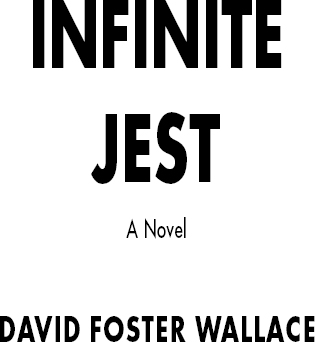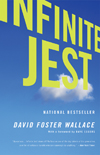Infinite Jest
Authors: David Foster Wallace




For F. P. Foster: R.I.P.
In recent years, there have been a few literary dustups—how insane is it that such
a thing exists in a world at war?—about readability in contemporary fiction. In essence,
there are some people who feel that fiction should be easy to read, that it’s a popular
medium that should communicate on a somewhat conversational wavelength. On the other
hand, there are those who feel that fiction can be challenging, generally and thematically,
and even on a sentence-by-sentence basis—that it’s okay if a person needs to work
a bit while reading, for the rewards can be that much greater when one’s mind has
been exercised and thus (presumably) expanded.
Much in the way that would-be civilized debates are polarized by extreme thinkers
on either side, this debate has been made to seem like an either/or proposition, that
the world has room for only one kind of fiction, and that the other kind should be
banned and its proponents hunted down and, why not, dismembered.
But while the polarizers have been going at it, there has existed a silent legion
of readers, perhaps the majority of readers of literary fiction, who don’t mind a
little of both. They believe, though not too vocally, that so-called difficult books
can exist next to, can even rub bindings suggestively with, more welcoming fiction.
These readers might actually read
both
kinds of fiction themselves,
sometimes in the same week.
There might even be—though it’s impossible to prove—readers who find it possible
to enjoy Thomas Pynchon one day and Elmore Leonard the next. Or even: readers who
can have fun with Jonathan Franzen in the morning while wrestling with William Gaddis
at night.
David Foster Wallace has long straddled the worlds of difficult and not-as-difficult,
with most readers agreeing that his essays are easier to read than his fiction, and
his journalism most accessible of all. But while much of his work is challenging,
his tone, in whatever form he’s exploring, is rigorously unpretentious. A Wallace
reader gets the impression of being in a room with a very talkative and brilliant
uncle or cousin who, just when he’s about to push it too far, to try our patience
with too much detail, has the good sense to throw in a good lowbrow joke. Wallace,
like many other writers who could be otherwise considered too smart for their own
good—Bellow comes to mind—is, like Bellow, always aware of the reader, of the idea
that books are essentially meant to entertain, and so almost unerringly balances his
prose to suit. This had been Wallace’s hallmark for years before this book, of course.
He was already known as a very smart and challenging and funny and preternaturally
gifted writer when
Infinite Jest
was released in 1996, and thereafter his reputation included all the adjectives mentioned
just now, and also this one: Holy shit.
No, that isn’t an adjective in the strictest sense. But you get the idea. The book
is 1,079 pages long and there is not one lazy sentence. The book is drum-tight and
relentlessly smart, and though it does not wear its heart on its sleeve, it’s deeply
felt and incredibly moving. That it was written in three years by a writer under thirty-five
is very painful to think about. So let’s not think about that. The point is that it’s
for all these reasons—acclaimed, daunting, not-lazy, drum-tight, very funny (we didn’t
mention that yet but yes)—that you picked up this book. Now the question is this:
Will you actually read it?
In commissioning this foreword, the publisher wanted a very brief and breezy essay
that might convince a new reader of
Infinite Jest
that the book is approachable, effortless even—a barrel of monkeys’ worth of fun
to read. Well. It’s easy to agree with the former, more difficult to advocate the
latter. The book is approachable, yes, because it doesn’t include complex scientific
or historical content, nor does it require any particular expertise or erudition.
As verbose as it is, and as long as it is, it never wants to punish you for some knowledge
you lack, nor does it want to send you to the dictionary every few pages. And yet,
while it uses a familiar enough vocabulary, make no mistake that
Infinite Jest
is something
other.
That is, it bears little resemblance to anything before it, and comparisons to anything
since are desperate and hollow. It appeared in 1996,
sui generis,
very different from virtually anything before it. It defied categorization and thwarted
efforts to take it apart and explain it.
It’s possible, with most contemporary novels, for astute readers, if they are wont,
to break it down into its parts, to take it apart as one would a car or Ikea shelving
unit. That is, let’s say a reader is a sort of mechanic. And let’s say this particular
reader-mechanic has worked on lots of books, and after a few hundred contemporary
novels, the mechanic feels like he can take apart just about any book and put it back
together again. That is, the mechanic recognizes the components of modern fiction
and can say, for example,
I’ve seen this part before, so I know why it’s there and what it does. And this one,
too
—
I recognize it. This part connects to this and performs this function. This one usually
goes here, and does that. All of this is familiar enough.
That’s no knock on the contemporary fiction that is recognizable and breakdownable.
This includes about 98 percent of the fiction we know and love.
But this is not possible with
Infinite Jest.
This book is like a spaceship with no recognizable components, no rivets or bolts,
no entry points, no way to take it apart. It is very shiny, and it has no discernible
flaws. If you could somehow smash it into smaller pieces, there would certainly be
no way to put it back together again. It simply
is.
Page by page, line by line, it is probably the strangest, most distinctive, and most
involved work of fiction by an American in the last twenty years. At no time while
reading
Infinite Jest
are you unaware that this is a work of complete obsession, of a stretching of the
mind of a young writer to the point of, we assume, near madness.
Which isn’t to say it’s madness in the way that Burroughs or even Fred Exley used
a type of madness with which to create. Exley, like many writers of his generation
and the few before it, drank to excess, and Burroughs ingested every controlled substance
he could buy or borrow. But Wallace is a different sort of madman, one in full control
of his tools, one who instead of teetering on the edge of this precipice or that,
under the influence of drugs or alcohol, seems to be heading ever-inward, into the
depths of memory and the relentless conjuring of a certain time and place in a way
that evokes—it seems so wrong to type this name but then again, so right!—Marcel Proust.
There is the same sort of obsessiveness, the same incredible precision and focus,
and the same sense that the writer wanted (and arguably succeeds at) nailing the consciousness
of an age.
Let’s talk about age, the more pedestrian meaning of the word. It’s to be expected
that the average age of the new
Infinite Jest
reader would be about twenty-five. There are certainly many collegians among you,
probably, and there may be an equal number of thirty-year-olds or fifty-year-olds
who have for whatever reason reached a point in their lives where they have determined
themselves finally ready to tackle the book, which this or that friend has urged upon
them. The point is that the average age is appropriate enough. I was twenty-five myself
when I first read it. I had known it was coming for about a year, because the publisher,
Little, Brown, had been very clever about building anticipation for it, with monthly
postcards, bearing teasing phrases and hints, sent to every media outlet in the country.
When the book was finally released, I started in on it almost immediately.
And thus I spent a month of my young life. I did little else. And I can’t say it was
always a barrel of monkeys. It was occasionally trying. It demands your full attention.
It can’t be read at a crowded café, or with a child on one’s lap. It was frustrating
that the footnotes were at the end of the book, rather than on the bottom of the page,
as they had been in Wallace’s essays and journalism. There were times, reading a very
exhaustive account of a tennis match, say, when I thought, well, okay. I like tennis
as much as the next guy, but enough already.
And yet the time spent in this book, in this world of language, is absolutely rewarded.
When you exit these pages after that month of reading, you are a better person. It’s
insane, but also hard to deny. Your brain is stronger because it’s been given a monthlong
workout, and more importantly, your heart is sturdier, for there has scarcely been
written a more moving account of desperation, depression, addiction, generational
stasis and yearning, or the obsession with human expectations, with artistic and athletic
and intellectual possibility. The themes here are big, and the emotions (guarded as
they are) are very real, and the cumulative effect of the book is, you could say,
seismic. It would be very unlikely that you would find a reader who, after finishing
the book, would shrug and say, “Eh.”
Here’s a question once posed to me, by a large, baseball cap–wearing English major
at a medium-size western college: Is it our duty to read
Infinite Jest?
This is a good question, and one that many people, particularly literary-minded people,
ask themselves. The answer is: Maybe. Sort of. Probably, in some way. If we think
it’s our duty to read this book, it’s because we’re interested in genius. We’re interested
in epic writerly ambition. We’re fascinated with what can be made by a person with
enough time and focus and caffeine and, in Wallace’s case, chewing tobacco. If we
are drawn to
Infinite Jest
, we’re also drawn to the Magnetic Fields’
69 Songs
, for which Stephin Merritt wrote that many songs, all of them about love, in about
two years. And we’re drawn to the ten thousand paintings of folk artist Howard Finster.
Or the work of Sufjan Stevens, who is on a mission to create an album about each state
in the union. He’s currently at State No. 2, but if he reaches his goal, it will approach
what Wallace did with the book in your hands. The point is that if we are interested
in human possibility, and we are able to cheer each other on to leaps in science and
athletics and art and thought, we must admire the work that our peers have managed
to create. We have an obligation, to ourselves, chiefly, to see what a brain, and
particularly a brain like our own—that is, using the same effluvium we, too, swim
through—is capable of. It’s why we watch
Shoah
, or visit the unending scroll on which Jack Kerouac wrote (in a fever of days)
On the Road
, or William T. Vollmann’s 3,300-page
Rising Up and Rising Down
, or Michael Apted’s
7-Up
,
28-Up, 42-Up
series of films, or… well, the list goes on.

